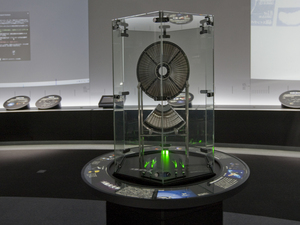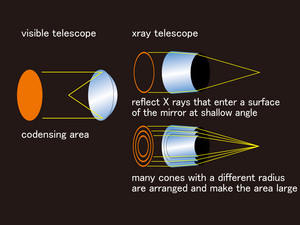Nagoya City Science Museum
TOP > Exhibition Guide > Keyword Search > Starting with "I" > ISAS > X-ray Astronomy
X-ray Astronomy



Purpose of Exhibition
X-ray astronomy is a branch of astronomy that studies high-energy and ultra-high-temperature phenomena in the Universe. The earth’s atmosphere absorbs and blocks X-rays from reaching the surface. So, it was not until the 1960s that a sounding rocket discovered the first cosmic X-ray source. Currently, space-based observations by satellites are the mainstream.
Japan has been leading the world in X-ray astronomy since the launch of the HAKUCHO satellite in 1970. Following HAKUCHO, Japan has successively launched four X-ray astronomy satellites: TENMA, GINGA, ASCA, and SUZAKU. However, the sixth Hitomi, launched in February 2016, suddenly lost communication and could not be restored. JAXA had to abandon the project before it could start full-scale observations. As of 2017, a replacement named XRISM is planned to launch in 2022.
This exhibit displays an actual X-ray mirror, the same as the one used for the real satellite ASCA, and will show you how the mirror collects X-rays in a specialized way with a model using laser beams.
Additional Knowledge
How does an X-ray telescope work?
[Specialized Mirrors for X-Ray Telescopes]
Astronomical telescopes in general are designed to form images on the focal plane with collecting faint light from celestial objects. However, unlike visible light, we cannot reflect X-rays or change their paths; for X-rays are highly penetrating light, as used in radiography, and they can pass through most things, including ordinary mirrors. So, how can we collect them?
Still, X-rays can be efficiently reflected off high precision metal mirrors at very shallow angles, say about one degree; an X-ray photon bounces when it barely grazes the surface, just like a stone skips across the water. This property allows us to gradually change the direction of travel of X-rays, by reflecting them many times at shallow angles.
Specifically, the mirrors of X-ray telescopes have the shape of a conical frustum, or a truncated cone, that is, a cone cut in a circle perpendicular to the central axis, as shown in the figure. The inside of a cone acts as a reflector and collects X-rays to the apex of the cone. A single conical mirror cannot collect enough X-rays due to its small collecting area for incident X-rays; so multiple mirrors are arranged like a Baumkuchen to gather more X-rays, as shown in the figure.
SUZAKU has five “thin-foil, multi-nested conical optics.” Each of them consists of 168 or 175 conical mirrors with different radii, stacked at intervals of around 1mm. The mirrors are made of very thin aluminum foils coated with gold. They have extremely precise alignment of the central axis and spacing, as well as smooth surface, in order to produce sharp images. Each of the five units is 40cm in diameter and weighs only less than 20kg. They were jointly developed by Nagoya University and Goddard Space Flight Center、GSFC/NASA.
This page was last edited on 15 June 2022.
Article by Astronomy Section
